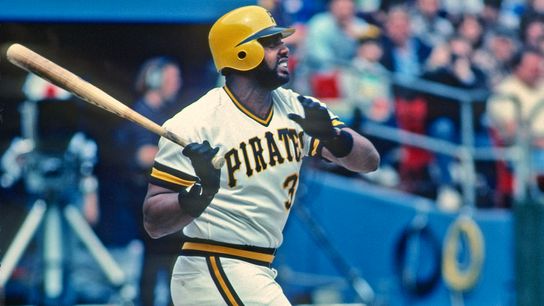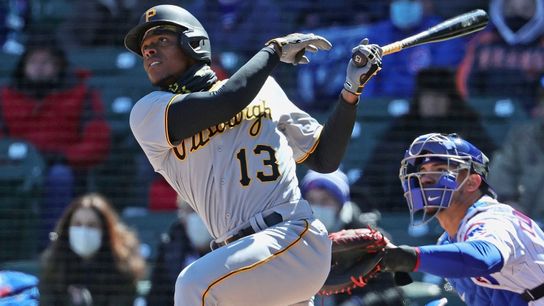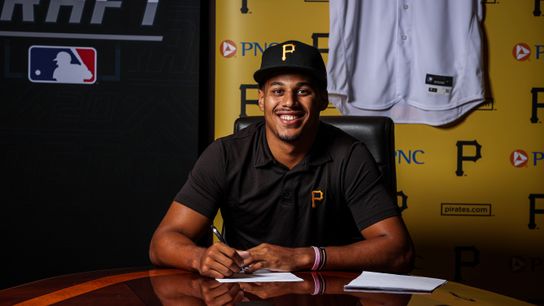Gene Clines vividly recalls the words of a young clubhouse attendant at Three Rivers Stadium as the Pirates’ outfielder arrived for a game that would make Major League Baseball history 50 years ago.
“The Homestead Grays are playing tonight,” the attendant said.
Clines knew all about the Grays — one of the iconic local entries in the Negro Leagues during the first half of the 20th century— but he didn’t understand the relevance to that night’s game against the Phillies. Minutes before Dock Ellis threw the first pitch, the reference clicked in Clines’ mind.
“It wasn’t until the National Anthem that I’m looking to my left and I’m looking to my right and, lo and behold, it was all brothers out there,” Clines said.
On Sept 1. 1971, the Pirates became the first big-league team to field an all-Black and Latino starting lineup. Rennie Stennett, Clines, Roberto Clemente, Willie Stargell, Manny Sanguillen, Dave Cash, Al Oliver, Jackie Hernandez, Ellis.
Injuries to two of the Pirates’ players and the matchup against the Phillies’ left-hander, Woodie Fryman, factored into manager Danny Murtaugh’s lineup card. It took several players an inning or two, however, to grasp the significance of the occasion.
That's partially because few clubs were as racially diverse as the Pirates in 1970s, a decade that delivered two World Series titles to Pittsburgh. Players were accustomed to lineups stacked with minorities. The 1979 squad that won the second championship featured 10 Black players on the roster.
“The older I’ve gotten, the more I’ve come to appreciate what happened on Sept. 1,1971,” said Oliver, 74, the former Pirates outfielder-first baseman. “I’m proud to be part of that history. It would be nice if it were a little more celebrated.”
Oliver made the comment on July 17 at PNC Park as the Pirates honored members of the ’71 championship team. The surviving players were introduced to warm applause just moments before the current squad took the field. The only Black player in the Pittsburgh lineup that night was third baseman Ke’Bryan Hayes. The entire roster includes just two African-Americans with relief pitcher Duane Underwood Jr. being the other.
The Pirates are hardly an exception in today’s game, which still features plenty of diversity thanks to Latino and Asian players in prominent roles, but that lags behind in African-American influence. In fact, three teams — Red Sox, Diamondbacks, Giants — did not have a single Black player on their opening-day rosters, according to a Boston Globe report.
Seventy-four years after Jackie Robinson broke the MLB color barrier, African-Americans represented just 7.6 percent of the 2021 opening-day rosters — down from a high point of 18.4 percent in 1984, according to the Society of Baseball Research.
“I think baseball has basically dropped the ball as far as promoting Black and Brown players,” Oliver said. “It’s always good to watch TV and see people who look like you. In basketball and football, you see it. Not in baseball.”
DK Pittsburgh Sports interviewed six former major-league players, two college coaches, a pro scout and one league executive to gauge opinions on the precipitous decline. No single reason was given for the dropoff, but several theories were repeatedly mentioned:
• The proliferation of youth travel teams and showcases are limiting the number of Black participants because of the financial costs associated.
• The escalating prices of equipment (bats, gloves, cleats).
• The paucity of college baseball scholarships in relation to football and basketball at a time when roughly 70 to 75 percent of the players who sign pro contacts come from the college ranks, said Tony Reagins, MLB’s chief baseball development officer.
• The pace of the game and the time it takes players to work through the minor leagues.
• The perception that not enough is being done by the teams and the league to market their Black players, as Oliver noted.
MLB initiatives are beginning to help reverse the trend as evidenced by the number of high picks in recent draft classes. But the league is nowhere close to returning to the days when Stargell, Hank Aaron, Willie Mays, Willie McCovey, Ozzie Smith, Barry Bonds, Dave Parker, Reggie Jackson, Andre Dawson, Ken Singleton and Darryl Strawberry were among the game’s biggest stars.
“It’s almost like climate change,” said Singleton, the former Orioles slugger who battled the Pirates in the 1979 World Series. “We’ve got to do something to change course here.”
____________________

GETTY
Dave Parker at Three Rivers Stadium in 1983.
Thirty-two years after being banished from the majors, Pete Rose remains as opinionated as ever about the game. Over the course of a 30-minute interview, baseball’s all-time hits leader jokes about the infield at old Forbes Field — “it was as hard as a (male appendage) on a wedding night” — and he rails about the length of today’s games.
“I watched a game the other night where the hitter stepped out of the box to readjust his batting gloves three times before a pitch was even thrown,” Rose said from his home in Las Vegas. “I watch games where there are like seven pitching changes. Who in the (expletive) wants to watch that? And that’s coming from someone who watches two games a day.”
Gambling on baseball earned Rose a lifetime ban in 1989, all but assuring he will never receive Hall of Fame enshrinement. A five-month prison sentence in 1990 for tax evasion didn't help.
That hasn’t stopped Rose from advocating for other players he deems Cooperstown worthy. He speaks glowingly of the rivalry his old Reds enjoyed with the Pirates in the ‘70s.
“Al Oliver was a helluva a hitter, and I’m not so sure he doesn’t belong in the Hall of Fame,” Rose said. “I’m telling you another guy who belongs in the Hall of Fame and I say this every (expletive) year — Dave Parker. Close to 3,000 hits, he’s a Gold Glover, he’s an MVP, a two-time world champion, a batting champion. What else do you (expletive) need? Yeah, I know about the cocaine (admissions), but If everyone played like Dave Parker, people wouldn’t be able to get away from their TV sets because they would be too busy watching baseball.”
Which leads Rose to his larger point. He appeared in 17 All-Star Games during a 24-year career, all while playing in the National League. Rose was on the winning side 16 times.
“I used to tell people the reason we were the better league is because we had more Black players,” Rose said. “Why did we have more Black players? I think I know the reason. We had all those ballparks with AstroTurf, and you needed speed on AstroTurf. Our teams had better speed in the outfield and better all-around athletes.”
In this year’s All-Star Game, Dodgers outfielder Mookie Betts was the only African-American initially named to the National League roster. He also was the only Black player to appear in last year’s World Series against the Rays.
Rose is one of several interviewed for this story who predicts a bright future for Hayes. Singleton believes the Pirates’ third baseman will evolve into a “perennial All-Star” if he remains healthy.
The league is doing a better job, Rose said, of promoting its international players — ones selected through free agency — but he thinks there’s room for improvement in hyping its African-American standouts.
When he gets the chance to speak with young athletes who excel in multiple sports, Rose said he lobbies hard for baseball.
“Show me a guy who’s played 24 years in the NBA or the NFL,” he said. “I tell these kids there’s more longevity in baseball. You might have to spend some time in the minors, but once you make it you can play for a long time and nobody has a better pension plan than baseball.”
Cash, a three-time All-Star over 12 seasons, agrees with Rose to a point. The former Pirates infielder said minor-league apprenticeships are viewed as a turnoff to some Black athletes.
“In football and basketball, you go right to the top out of college,” Cash said. “It’s not as much about the money as it is getting to the big leagues quicker in football and basketball. We lose a lot of baseball players that way.”
Longtime Chicago White Sox scout Joe Butler echoes another Rose talking point about the length of games.
“Growing up in Los Angeles, a lot of us saw baseball as ‘cool,’ kids wanted to play the game,” said Butler, who is Black. “Nowadays, there’s a lot more standing around and some think it’s boring. There’s a rush you get on Friday nights playing football and playing basketball."
____________________

GETTY
Ke'Bryan Hayes at Wrigley Field in 2021.
University of Louisville assistant baseball recruiting coordinator Eric Snider first saw catcher Henry Davis play at a summer showcase in Florida seven years ago. Davis, the No. 1 overall pick of the Pirates in the 2021 draft, was in eighth grade at the time.
Snider offered him a scholarship to Louisville the following year.
The parents of Davis, who grew up in Bedford, N.Y., had the economic means to cover the cost of expenses for travel-ball tournaments and showcases. It was Davis’ relentless drive that ultimately allowed him to attain his goals, but his parents' financial backing also helped purchase a pitching machine and quality baseball equipment.
Top-of-the-line aluminum bats can cost more than $300. Baseball gloves can top $200 and cleats can run $100. But the serious investment involves summer travel leagues and showcases, the kind that draw "herd scouting" from pro and college talent evaluators, Reagins said.
“Somebody is making a lot of money on this stuff, obviously,” Snider said. “A family has to have money to be able to do all these things.”
Ohio State baseball coach Greg Beals made a similar observation.
“We are putting these kids in a position where they need be on these travel teams,” he said. “There aren’t a lot of local teams. American Legion ball is dwindling dramatically. And so you have this travel ball-type mentality all around, which is basically a pay-to-play situation.”
Alex Kerman, of the Sports & Fitness Industry Association, noted baseball has been the second-fastest growing team sport in terms of participation behind only rugby in recent years, according to survey data. He added that local recreation leagues have been slow to recover from the impact of COVID-19 shutdowns, while elite travel ball circuits have bounced back strong.
Pro scouts have the flexibility to monitor prep players during high school and travel ball seasons. That’s not often the case with college scouts. High school and college baseball seasons run concurrently. It means Division I college staffs, which typically employ three or four coaches, do a majority of their prospect evaluation during the summer.
“Are we eliminating kids?” Beals said. “Are we making it very difficult for some kids and families to make that (financial) commitment on the baseball side?”
The youth baseball evolution has helped turn the game, in Singleton’s view, into a “suburban sport.” He grew up just outside of New York City and played in the shadow of Yankee Stadium in the Bronx Federation League against future Hall of Famer Rod Carew.
Clines said he was discovered on the sandlots of Richmond, Calif. Butler can’t count the number of African-American stars from the 1970s and 1980s who made their names on the inner-city diamonds of Los Angeles.
Dawson, the Hall of Fame slugger from Miami, Fla., said the stories sound all too familiar.
“This didn’t just happen,” Dawson said. “It’s been a slow downward trend in the urban communities. The game has gotten to be on the expensive side. Travel teams can be pricy for lower-income families. The kids seem to lean more toward football and basketball. . . . We’re losing a generation of kids whose fathers identify more with Michael Jordan, LeBron James and Kobe Bryant.”
Division I college baseball teams have fewer scholarships to offer than football and basketball and that they rarely come in the form of full rides. Reagins estimated that African-Americans represent about four percent of players in the Division I college baseball ranks.
“Families are having to decide whether to play baseball and pay money out of pocket or, if the kids are good enough in other sports, to let them pursue basketball or football, where they can get a full ride,” he said.
____________________

PITTSBURGH PIRATES
Lonnie White Jr. signs his contract with the Pirates.
It's great to be an 18-year-old kid with options, and Lonnie White Jr. had several enticing ones this summer. Penn State's football program already had offered the two-sport standout from Malvern, Pa., located just outside of Philadelphia, a scholarship to play wide receiver. His prowess on the diamond also earned him a first-round grade from Baseball America.
The outfielder slipped to the Pirates at No. 64 overall because some teams worried he would honor the Penn State commitment. Clubs don’t want to risk a high pick on an athlete who might spurn them for college football or basketball.
The Pirates, who had the most money to spend in the MLB draft bonus pool, secured White’s signature and awarded him an over-slot sum of $1.5 million. They also signed outfielder Braylon Bishop, the 87th ranked prospect by Baseball America, in the 14th round, giving him an over-slot bonus of $270,300 to walk away from a University of Arkansas baseball schollarship.
“This is just a dream come true to me,” White said Monday.
It also was an encouraging sign for those hoping to repopulate pro baseball with more gifted Black players.
“Obviously, there’s work that needs to be done at the Major League Baseball level in terms of African-Americans,” Reagins said. “(But in the) last four or five drafts, a significant number of African-Americans have been taken high.”
Reagins spent last week at the Hank Aaron Invitational, which is run by the MLB and the MLB Players Association. The two-week event in Vero Beach, Fla., showcases youth players from diverse backgrounds, while providing training and instruction from former major leaguers and coaches.
Pittsburgh native Brandon McLain-Banks of Barack Obama Academy of International Studies was among the participants. The Aaron Invitational is one of several MLB initiates -- others include the Breakthrough Series, DREAM Series, and Reviving Baseball in Inner Cities (RBI). A youth team representing the Pirates is headed to the RBI World Series, which begins next week.
Among the alumni in these programs are first-round picks Kumar Rocker (Mets) and Harry Ford (Mariners) from this year, Simeon Woods-Richardson (Mets) from 2018 and Hunter Greene (Reds) from 2017.
“We are building a foundation with a lot of the programs we’ve implemented at the youth level,” said Reagins, a former Angels general manager. “This is not going to change overnight. I thought when I came to the (MLB) commissioner’s office (in 2015) this was something that was going to take five years to kind of right the ship. I was wrong.”
Searching for ways to bolster the 7.8 percent participation level, MLB executives announced on July 12 they are committing up to $150 million over a 10-year span to the Players Alliance, which aims to create an inclusive culture and supply greater opportunities for the Black community.
“You keep hearing African-Americans aren’t playing the game,” Reagins said. “I’m down here in Florida with a lot of African-American kids who are playing the game. I’m here with some former players who laugh at the thought that African-Americans aren’t playing.”
Braylon in the Burgh pic.twitter.com/KcVBzTRmXU
— Young Bucs (@YoungBucsPIT) July 28, 2021
Butler recently was scouting a game in Anaheim when he looked around the stadium and saw Japanese flags waving every time Shohei Ohtani came to bat.
“You could just feel the pride,” Butler said. “You could tell how much Shohei’s success meant to them.”
Singleton relates to the story. He can recall the moment that spurred his lifelong love of baseball.
His father took him to a Brooklyn Dodgers doubleheader at old Ebbets Field in the 1950s. The Dodgers’ lineup included Robinson, Roy Campanella, Jim Gillam and Don Newcombe.
“I just sat there and took it all in,” Singleton said. “I don’t think I got up from my seat except to go to the bathroom. Getting the chance to see all those great players was inspirational.”
Singleton was playing for the Mets in 1971 when news of the Pirates’ all-Black and Latino lineup reached him. He doesn’t recall having a memorable reaction, but to those players involved in the game at Three Rivers Stadium, it meant something special. In their minds, the achievement has grown in stature even as the number of Blacks on MLB diamonds has diminished.
“That was one of the most prideful days of my entire career,” Clines said. “It’s like setting a record and having it still stand 50 years later.”

